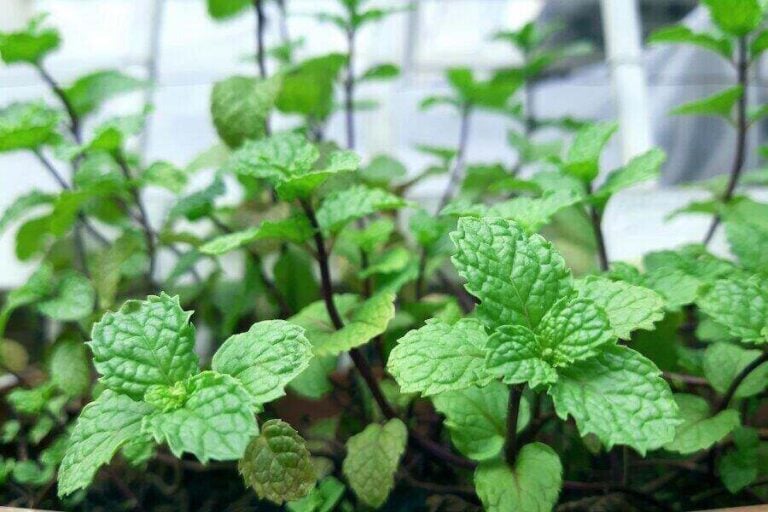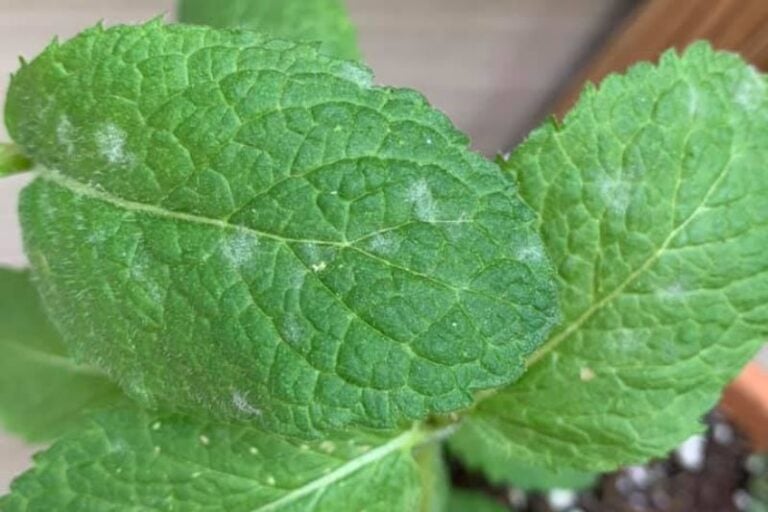If you’re interested in growing mint then you, like the rest of us, almost definitely want to make sure that you get it all right. One important aspect of growing any plant is making sure that the root system has enough space to grow.
Common mint species like peppermint and spearmint will have root systems between 2-24 inches (5-61 cm) deep. There are over 23 species of mint and each of them grows roots to different depths. A 12 inch (30 cm) deep container is enough for your mint to survive.
Read on and I’ll show you what you can do to make sure that your mint has the best chance of not just surviving, but flourishing with a healthy root system.
Planting Depth
When planting any plant it’s important to make sure that you have it at the right depth.
If you bury the plant too near the surface it may become dislodged and move to a less favorable position to grow.
There’s nothing quite so disappointing as seeing your plants float away! The opposite of this problem is placing the mint plants too deep.
When this happens, the plant may not be able to reach the surface before it runs out of energy in the seed and dies underground.
Each species of mint will have different optimal planting depths however most mint plants should be placed about a quarter-inch (0.6cm) beneath the soil. This helps to place the plant in a place where it isn’t too high or too low.
Mint Planting Measurements
| Planting Depth | ¼ inch (.6cm) |
| Root Depth | 2-24 inches (6cm-61cm) |
| Plant Height | 12-40 inches (30cm-101cm) |
| Plant Spacing | 12 inches in beds (30cm) |
Distance Between Plants
There should be at least 12 inches (30cm) of spacing between plants in flower beds.
This range increases to 18-24 inches (45-61 cm) of space between mint plants when they are placed in containers.
This will help you to keep your plants separate and give them enough space to grow properly!
Mint Root System
As we’ve already seen mint can grow to depths of up to 24 inches (61 cm). This means that mint has quite a shallow root system compared to many plants.
You should know that doesn’t mean you can relax and think that mint will be an easy plant to grow, in fact, there is another important part of the root system to consider.
The root system of mint plants frequently spreads out easily and could even be considered invasive. Although mint roots are not deep, they do have a tendency to spread out wide quickly.
A mint plants’ roots (rhizomes) can grow out far from the original plant that brought it into existence.
Mint Root Depth Factors
For this reason, it is important to ensure that you have control over the growth of the mint.
I’ve included in the FAQ down below the best way to make sure that your mint plants don’t take over your garden at the expense of your other plants.
There are a few different things that could affect the growth of your mint plants’ roots.
If you believe that your plants are not growing properly or the root system is not deep enough for the plants to grow properly there are a number of factors for you to explore to make sure that your plants grow successfully.
I’ll go through each factor below and help you to figure where you could improve.
Mint Variety
There are currently 23 recognized species of mint and each of them can grow to different lengths.
Spearmint can grow between 12 and 39 inches (30-100 cm) tall whilst wild Japanese peppermint grows between 4 and 24 inches (10-60 cm) tall.
Mint Plants that are taller also tend to have deeper root systems to help provide support for the plant.
If you think that your plant isn’t growing tall enough you should make sure that you’re growing the right type of mint for your needs.
Although it may seem like some of your mints aren’t growing as tall as the others there are multiple distinct species that can all grow to different lengths.
Container Depth
It is recommended that you grow your mint in a pot that is at least 12 inches (30 cm) deep.
If you decide to grow your mint in a container that is less than 12 inches deep it may hinder its growth.
If there are holes in the bottom of the container the roots may attempt to grow out of the container however their growth will still be stalled.
Container Width
If you want to get the most out of your mint plants you should try to plant them in a container that is at least 8 inches (20 cm) wide to get the most out of your mint.
We can see from the last two headings that making sure your plant has enough space to grow is a key aspect of growing mint!
Soil Structure
Mint tends to grow best when it is in healthy, reasonably wet soil. The soil should contain about a third of humus content.
It should also include a one-third landscape to increase drainage. Other items such as vermiculite and perlite can also increase the soils’ drainage capacity.
This is an important part of picking the right soil as without it water will begin to collect in the soil around the plant.
Too little water is often associated with dying plants however too much water can be equally as problematic. A waterlogged plant will not grow as well as one in healthy soil.
Soil Quality
The soil should not be too acidic or basic (in scientific terms the soil should have a pH of around 7).
The Soil should contain nutrients and organic matter to feed the mint and allow it to grow.
Micro-organisms within the soil will then allow the mint to grow to its full potential.
You May Also Enjoy: Why Are My Mint Leaves Turning Black? (Causes and Solutions)
Sunlight
Mint requires full or partial sunlight much of the day in order to grow. If you are keeping your mint in a container hidden away from the sun it may not grow as it would in better conditions.
If the Plant is being placed within your house you should make sure it is somewhere with plenty of sunlight.
You should be careful to make sure blinds don’t get in the way of providing sunlight to the plant.
FAQ’s
Does mint need deep soil?
Mint in general does not deep soil to grow. Mint should be grown in containers at least 12 inches deep in order to ensure enough space for the plant.
Is mint shallow rooted?
Mint is quite a shallow-rooted plant compared to many. This is actually a benefit as it allows you to use smaller pots to grow them and lets you save the big ones for your other flora.
Mint can grow up to 24 inches however depth of 12 inches is enough for the mint to survive in containers.
How far can mint spread?
Mint is a plant that can spread quickly and far in the right conditions. Mint can extend to any distance if the conditions are right for its growth and for this reason some people consider the plant invasive.
If you are growing mint you should ensure that it does not take away space from your other plants.
How do I prevent the mint from Spreading?
One way to prevent the mint from spreading is to plant it in containers. An alternative is to place mint in a pot and then place it in the flowerbed with the mint inside.
In this way, the mint roots cannot extend through the soil beyond the pot and its roots are contained.
How much room does a mint plant need?
If planting in a pot it should be at least inches deep and 8 inches wide to ensure proper space for the mint to grow properly.
How do I make my mint plant bushy?
Some people want their mint plants to be bushy in order to change their appearance or to attempt to allow the creation of more mint leaves in less space.
This could be of benefit for anyone working on making a tight, cozy space have the most impact.
To make the mint plant bushy the top 2 to 4 leaves of the plant should be ripped off carefully. This will then make the mint grow out.
Is it okay to place mint near other plants?
Mint competes for resources with any other plants it comes into contact with. Mint is also quite a sturdy plant so for this reason, it is not recommended to place mint near other plants you want to protect. An alternative to flower beds is containers.
What is the best way to plant Mint?
In general, it is a good idea to use cuttings from one mint plant to create a new one. One reason for this is the cuttings grow more reliably than seeds in most environments.
Another reason for this is that a large number of species of mint can mean that the wrong type of mint may be planted leaving you surprised with the results!







